Cardinals created by Alexander VI
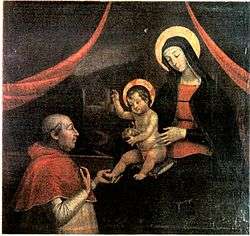
Pope Alexander VI (1431-1503).
Pope Alexander VI (r. 1492–1503) created 43 new cardinals in 9 consistories:

Juan de Borja Lanzol(Llançol) de Romaní, el mayor
31 August 1492
- Juan de Borja-Llanzol(Llançol) de Romani, papal nephew, archbishop of Monreale – cardinal-priest of S. Susanna, † 1 August 1503
20 September 1493
All the new cardinals received the titles on 23 September 1493.

Bernardino López de Carvajal (1455-1523), made a cardinal on September 20, 1493.

Cesare Borgia (1475-1507), made a cardinal on September 20, 1493.
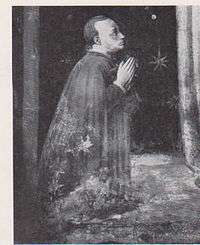
Giuliano Cesarini (1466-1510), made a cardinal on September 20, 1493.
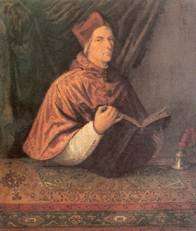
Domenico Grimani (1461-1523), made a cardinal on September 20, 1493.
- Jean Bilhères de Lagraulas, O.S.B., bishop of Lombès, ambassador of the King of France – cardinal-priest of S. Sabina, † 6 August 1499
- Giovanni Antonio Sangiorgio, bishop of Alessandria – cardinal-priest of SS. Nereo ed Achilleo, then cardinal-bishop of Tusculum (23 December 1503), cardinal-bishop of Palestrina (17 September 1507), cardinal-bishop of Sabina (22 September 1508), † 14 March 1509
- Bernardino López de Carvajal, bishop of Cartagena – cardinal-priest of SS. Marcelino e Pietro, then cardinal-priest of S. Croce in Gerusalmme (2 February 1495), cardinal-bishop of Albano (3 August 1507), cardinal-bishop of Tusculum (17 September 1507), cardinal-bishop of Palestrina (22 September 1508), cardinal-bishop of Sabina (28 March 1509); excommunicated and deposed on 24 October 1511 for his participation in the schismatic pseudo-council of Pisa; reinstated on 27 June 1513 as cardinal-bishop of Sabina, then cardinal-bishop of Ostia e Velletri (24 July 1521), † 16 December 1523
- Cesare Borgia, Son of the Pope – cardinal-deacon of S. Maria Nuova; resigned his cardinalate on 18 August 1498, † 12 March 1507
- Giuliano Cesarini, iuniore – cardinal-deacon of SS. Sergio e Bacco, then cardinal-deacon of S. Angelo (12 June 1503), † 1 May 1510
- Domenico Grimani – cardinal-deacon of S. Nicola inter Imagines, then cardinal-priest of S. Nicola inter Imagines (28 March 1498), cardinal-priest of S. Marco (25 December 1503), cardinal-bishop of Albano (22 September 1508), cardinal-bishop of Tusculum (3 June 1509), cardinal-bishop of Porto e Santa Rufina (20 January 151), † 27 August 1523
- Alessandro Farnese – cardinal-deacon of SS. Cosma e Damiano, then cardinal-deacon of S. Eustachio (11 October[1] 1503), cardinal-bishop of Tusculum (15 June 1519), cardinal-bishop of Palestrina (9 December 1523), cardinal-bishop of Sabina (18 December 1523), cardinal-bishop of Porto e Santa Rufina (20 May 1524), cardinal-bishop of Ostia e Velletri (15 June 1524), became Pope Paul III on 13 October 1534, † 10 November 1549
- Bernardino Lunati – cardinal-deacon of S. Ciriaco, † 8 August 1497
- Raymond Peraudi, O.S.A., bishop of Gurk – cardinal-deacon of S. Maria in Cosmedin, then cardinal-priest of S. Vitale (1494), cardinal-priest of S. Maria Nuova (29 April 1499), † 5 September 1505
- John Morton, archbishop of Canterbury – cardinal-priest of S. Anastasia, † 15 September 1500
- Fryderyk Jagiellończyk, administrator of Kraków – cardinal-priest of S. Lucia in Septisolio, † 14 March 1503
- Ippolito d'Este, administrator of Esztergom – cardinal-deacon of S. Lucia in Silice, † 3 September 1520
May 1494
- Luigi d'Aragona – cardinal-deacon of S. Maria in Cosmedin, † 21 January 1519
16 January 1495
.jpg)
Guillaume Briçonnet (d. 1514), made a cardinal on January 16, 1495.
- Guillaume Briçonnet, bishop of St.-Malo – cardinal-priest of S. Pudenziana,then cardinal-bishop of Albano (17 September 1507), cardinal-bishop of Tusculum (22 September 1508), cardinal-bishop of Palestrina (3 June 1509); excommunicated and deposed on 24 October 1511 for his participation in the schismatic pseudo-council of Pisa; reinstated on 7 April 1514 as cardinal-priest of S. Pudenziana,[2] † 14 December 1514
21 January 1495
- Philippe de Luxembourg, bishop of Le Mans – cardinal-priest of SS. Marcellino e Pietro (received the title on 2 February 1495), then cardinal-bishop of Albano (3 June 1509), cardinal-bishop of Tusculum (20 January 1511), † 2 June 1519
19 February 1496
All the new cardinals received the titles on 24 February 1496.
- Juan López, bishop of Perugia – cardinal-priest of S. Maria in Trastevere, † 5 August 1501
- Bartolomé Martí, bishop of Segorbe – cardinal-deacon of S. Agata in Suburra, † 25 March 1500
- Juan de Castro, bishop of Agrigento – cardinal-priest of S. Prisca, † 29 September 1506
- Juan de Borja Lanzol de Romaní, el menor, relative of the Pope, bishop-elect of Melfi – cardinal-deacon of S. Maria in Via Lata, † 17 January 1500
17 September 1498
- Georges d'Amboise, archbishop of Rouen – cardinal-priest of S. Sisto, † 25 May 1510
28 September 1500
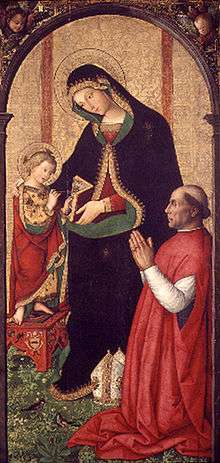
Francisco de Borja (1441-1511), made a cardinal on September 28, 1500.
.jpg)
Gianstefano Ferrero (1474-1510), made a cardinal on September 28, 1500.
- Diego Hurtado de Mendoza y Quiñones, archbishop of Seville – cardinal-priest of S. Sabina (received the title on 5 October 1500), † 14 October 1502
- Amanieu d'Albret – cardinal-deacon of S. Nicola in Carcere (received the title on 5 October 1500), † 20 December 1520
- Pedro Luis de Borja Lanzol de Romaní, O.S.Io.Hieros., archbishop-elect of Valencia – cardinal-deacon of S. Maria in Via Lata (received the title on 5 October 1500), then cardinal-priest of S. Marcello (7 December 1503), † 4 October 1511
- Jaume Serra i Cau, archbishop of Oristano – cardinal-priest of S. Vitale (received the title on 5 October 1500), then cardinal-priest of S. Clemente (28 June 1502), cardinal-bishop of Albano (20 January 1511), † 15 March 1517
- Pietro Isvalies, archbishop of Reggio di Calabria – cardinal-priest of S. Ciriaco (received the title on 5 October 1500), then cardinal-priest of S. Pudenziana (18 August 1507), † 22 September 1511
- Francisco de Borja, archbishop of Cosenza – cardinal-priest of S. Cecilia (received the title on 5 October 1500), then cardinal-priest of SS. Nero ed Achilleo (11 August 1506), † 4 November 1511
- Juan de Vera, archbishop of Salerno – cardinal-priest of S. Balbina (received the title on 5 October 1500), † 4 May 1507
- Ludovico Prodocator, bishop of Capacio – cardinal-priest of S. Agata in Suburra (received the title on 5 October 1500), † 25 August 1504
- Antonio Trivulzio, O.C.R.S.A., bishop of Como – cardinal-priest of S. Anastasia (received the title probably in November 1500[3]), then cardinal-priest of S. Stefano in Monte Celio (1 July 1504),[4] † 18 March 1508
- Giovanni Baptista Ferrari, bishop of Modena – cardinal-priest of S. Crisogono (received the title on 5 October 1500), † 20 July 1502
- Tamás Bakócz, archbishop of Esztergom, chancellor of the Kingdom of Hungary – cardinal-priest of SS. Silvestro e Martino (received the title probably in November 1500[5]), † 11 June 1521
- Marco Cornaro – cardinal-deacon of S. Maria in Portico (received the title on 5 October 1500), then cardinal-deacon of S. Maria in Via Lata (19 March 1513), cardinal-priest of S. Marco (14 December 1523), cardinal-bishop of Albano (20 May 124), cardinal-bishop of Palestrina (15 June 1524), † 24 July 1524
- Gianstefano Ferrero, bishop of Vercelli (in pectore, published on 28 June 1502) – cardinal-priest of S. Vitale (received the title on 28 June 1502), then cardinal-priest of SS. Sergio e Bacco (22 December 1505), † 5 October 1510
31 May 1503
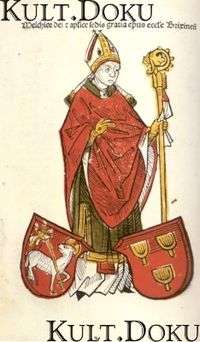
Melchior von Meckau (1440-1509), made a cardinal on May 31, 1503.
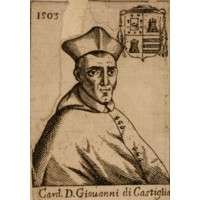
Juan Castellar y de Borja (1441-1505), made a cardinal on May 31, 1503.
- Juan Castellar y de Borja, archbishop of Trani – cardinal-priest of S. Maria in Trastevere (received the title on 12 June 1503), † 1 January 1505
- Francisco de Remolins, archbishop of Sorrento – cardinal-priest of SS. Giovanni e Paolo (received the title on 12 June 1503), then cardinal-priest of S. Marcello (27 October 1511), cardinal-bishop of Albano (16 March 1517), † 5 February 1518
- Francesco Soderini, bishop of Volterra – cardinal-priest of S. Susanna (received the title probably on 11 October 1503[6]), then cardinal-priest of SS. XII Apostoli (15 September 1508), cardinal-bishop of Sabina (29 October 1511), cardinal-bishop of Tivoli (27 June 1513), cardinal-bishop of Palestrina (18 July 1516), cardinal-bishop of Porto e Santa Rufina (9 December 1523), cardinal-bishop of Ostia e Velletri (18 December 1523), † 17 May 1524
- Melchior von Meckau, bishop of Brixen – cardinal-priest of S. Nicola inter Imagines (received the title on 25 December 1503), then cardinal-priest of S. Stefano in Monte Celio (4 January 1509?[7]), † 3 March 1509
- Niccolò Fieschi, bishop-elect of Fréjus – cardinal-priest of S. Lucia in Septisolio (received the title on 12 June 1503), then cardinal-priest of S. Prisca (5 October 1506), cardinal-bishop of Albano (5 February 1518), cardinal-bishop of Sabina (24 July 1521), cardinal-bishop of Porto e Santa Rufina (18 December 1523), cardinal-bishop of Ostia e Velletri (20 May 1524), † 15 June 1524
- Francisco Desprats, bishop of Leon – cardinal-priest of SS. Sergio e Bacco (received the title on 12 June 1503), † 10 September 1504
- Adriano Castellesi, bishop of Hereford – cardinal-priest of S. Crisogono (received the title on 12 June 1503); excommunicated and deposed on 5 July 1518, † December 1521
- Jaime de Casanova – cardinal-priest of S. Stefano in Monte Celio (received the title on 12 June 1503), † 4 June 1504
- Francisco Lloris y de Borja, bishop of Elne – cardinal-deacon of S. Sabina (received the title on 12 June 1503), then cardinal-deacon of S. Maria Nuova (17 December 1505), † 22 July 1506
Notes
- ↑ Eubel, III, p. 5, says, that Alessandro Farnese was transferred from the deaconry of SS. Cosma e Damiano to that of S. Eustachio on 29 November 1503. But He actually occupied the deaconry of S. Eustachio already during the conclave on 1 November 1503 (Annales Ecclesiastici, vol. 35, p. 395). He must have opted for this deaconry during the short pontificate of Pius III, who himself had been cardinal-deacon of S. Eustachio before his election to the Papacy. Diary of Johann Burchard registered only one consistory under Pius III – it took place on 11 October 1503
- ↑ He shared this title with Cardinal Matthäus Schinner of Sion.
- ↑ According to Eubel, II, p. 24, n. 1, all the cardinals created and published on 28 September 1500 received their titles on 5 October 1500. Eubel cites Diary of Johann Burchard, p. 76-82, but Burchard says that on that Day the titles were given to those present, while some absent received their titles somewhat later. Trivulzio couldn’t have received the title of S. Anastasia before 1 November 1500 because only on that day the news of the death of Cardinal Morton, his predecessor in this title, reached Rome (cf. Eubel, II, p. 55).
- ↑ Eubel, III, p. 7, says that on 4 January 1507 Trivulzio opted for unknown title but this is unlikely because at the time of his death he was still cardinal-priest of S. Stefano, cf. Annales Ecclesiastici, vol. 30, p. 493. Besides, he also subscribed the bull issued on 1 December 1507 as cardinal-priest of S. Stefano, see Bullarium Romanum, ed. Augustinae Taurinorum, Tomus IV, 1859, p. 464.
- ↑ According to Eubel, II, p. 24, n. 1, all the cardinals created and published on 28 September 1500 received their titles on 5 October 1500. Eubel cites Diary of Johann Burchard, p. 76-82, but Burchard says that on that day the titles were given to those present, while some absent received their titles somewhat later. The title of SS. Silvestro e Martino was occupied by Cardinal d'Espinay until his death on 11 November 1500, and the news of his death reached Rome only on 23 November 1500 (cf. Eubel, II, p. 55).
- ↑ Soderini must have received this title after 1 August 1503 (death of Cardinal Borja Lanzol de Romani) and before the death of Pius III, because he appears as cardinal-priest of S. Susanna in the papal conclave on 1 November 1503. Since Pope Alexander VI died 18 August 1503 and neither Eubel nor Burchard recorded any consistory in August 1503, he must have received the title of S. Susanna in the only consistory of Pius III on 11 October 1503.
- ↑ Eubel, III, p. 70, gives the date 4 January 1507, but see Beschreibende Darstellung der älteren Bau- und Kunstdenkmäler des Königreichs Sachsen, 40, p. 477. The title of S. Stefano was assigned to cardinal Antonio Trivulzio until 18 March 1508. On 1 December 1507 Melchior von Meckau subscribed papal bull as cardinal-priest of S. Nicola inter Imagines and on the same bull Antoni Trivulzio subscribed as cardinal-priest of S. Stefano in Monte Celio , see Bullarium Romanum, ed. Augustinae Taurinorum, Tomus IV, 1859, p. 464.
Sources
- The Cardinals of the Holy Roman Church
- Konrad Eubel, Hierarchia Catholica, vol. II, Münster 1914 and vol. III, Münster 1922
This article is issued from Wikipedia - version of the 7/28/2016. The text is available under the Creative Commons Attribution/Share Alike but additional terms may apply for the media files.